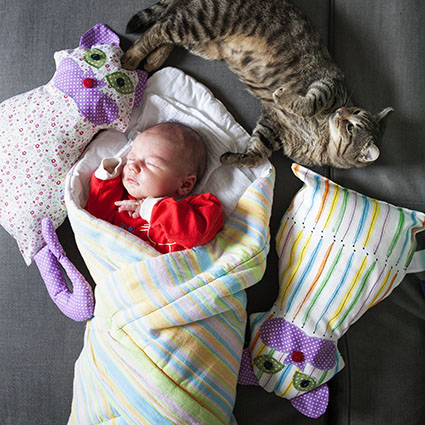Sometimes there are days we just want to forget about. It would be better if these days never happened. In the last few months I had few of those days…few too many. Everything because of FIP, a cats’ disease, I have nightmares about, I have read tons of materials on but neither the extensive reading nor writing helps. When I started volunteering in the foundation I used to hear of diseases such as panleukopenia or leukemia; I didn’t know much about FIP so I thought it couldn’t be too dangerous but soon enough I was proved very wrong. FIP – Feline infectious peritonitis – killed 15 of my cats in the last 8 months. Unfortunately it presented itself under different mutated forms so we initially thought that the cats were suffering from different diseases. Can we prevent FIP? Vaccinations, checking for the presence of the virus….are they effective?
Cats’ disease – FIP (ang. Feline infectious peritonitis)
FIP is called a young cats’ disease.
It means it is mostly attacking cats that do not have strong immune systems. Very common Feline enteric coronavirus attacks first, then mutates making the cats sick and causing their deaths. Unfortunately not only young cats are vulnerable but all cats that come in contact with the virus, which is transmitted through secretions such as feces or saliva. If the cats are exposed to the virus whether they get sick or not depends on the strength of their immune system. We need to remember that any cat can be a carrier of this virus, also your cats that have been living with you for years and your cats might not get sick because they are strong enough but they might get another weaker cats sick. Young cats are more susceptible because, like little children’s, their immune systems are not well developed making the virus more dangerous than for grownups. Adult cats can also get sick, even if they were vaccinated earlier their body might not be able to handle the virus (FIP and FIV vaccinations are not included in the basic set of vaccines, they are additional and only about 15% of cats gets additional vaccines).
What is FIP? What are its symptoms and characteristics?
There are two forms of the disease: effusive (wet) and non-effusive (dry).
The wet form leads to serious inflammation of serous membranes with accumulation of yellow, sticky, fibrinous fluid in the abdominal cavity. In the dry form the internal organs are covered all over with granulomas. Cat is anemic, has fever and jaundice. Sometimes a cat with dry FIP will show ocular or neurological signs. This is what books say, what we, the owners, see is weight loss due to lack of appetite, secretions from eyes and nose and a growing belly in spite of weight loss…there are many symptoms and they are not always pointing directly to FIP.
What increases the risk of getting sick?
We need to remember that cats are vulnerable animals, especially to various diseases. Even small stress lowers their immunity and increases risk of catching some illness. It is crucial that every potentially stressful situation – such as changing houses, bringing a new person to the house, vaccinations – is accompanied by attempts to increase cats’ immunity for example by giving them pills (available in pet stores, on the Internet or in the vet’s office) containing Beta 1,3/1,6 and glucan, a substance helping cats fight various viruses.
You need to remember about “3 magic weeks” rule! What is it? After you adopt cats wait for a minimum of three weeks before you vaccinate them, sterilize them or perform any other procedures on them. We can’t stress cats with house change and then inject them with a big dosage of antigens which weaken the immune system temporarily. Such vaccinations can do more bad than good so please wait at least 3 weeks or more if possible before you administer any.
Is it possible to detect FIP?
It is said that it is impossible to in living cats. There are few indicators that might point to FIP but unfortunately there is no particular test that would clearly point to FIP.
Is it possible to cure FIP?
Unfortunately FIP is not curable. Vets can prescribe immuno-suppressive drugs such as corticosteroids or cyclophosphamide which can slow down the disease a bit but do not change the final outcome. There have been attempts to use Interferon Omega to treat FIP but the results were not promising. I wrote to two American professors who research FIP and try to find a cure and here are their answers:
>Dear Ms. Kucko: Your problems with FIP are being shared by kitten rescue organizations all over the world. The problem is that they are taking kittens at a very young age, bottle feeding many of them, and mixing many litters of different ages in limited space. The husbandry and logistics in these rescue facilities favor high levels of FECV infection at a young age, which in turn favors the occurrence of the FIP mutation. The FIP can occur within weeks or it can incubate for months before becoming clinical. I really do not know what else to say, because without drastic changes in facilities, husbandry, and mind set about taking kittens out of the environment when they are to young, the problem will only get worse. – Dr. Pedersen
Dear Katarzyna,
There is no treatment at this time that is very effective. We have been working with Polyprenyl Immunostimulant for the treatment of dry form FIP. We see a 5-8% one year plus survival in cats with dry FIP with a few long term survivors. The Polyprenyl does make most of the cats feel better. The Polyprenyl needs to be treated long term at a cost of $150 to 200 a month. I have attached summaries of my presentations at the AAHA and ACVIM meetings. Dr. Neils Pedersen at the University of California is currently working on an anti-viral drug but the cats have to go to California and there is not a lot of drug available.
I wish I had better information for you.
Best wishes,
Al Legendre
My friend recently told me that there is quite a lot of information about FIP in the books but they mostly focus on the terrible effects of FIP on cats’ body, how fast and mercilessly it spreads and how difficult it is to detect it. At the end of each of these books there is a space for treatment section but unfortunately this section includes only few sentences as the cure is non existent as of now.
It is devastating when you take cats in, start loving them and FIP takes them away. I wish more could be done to fight this terrible disease.







